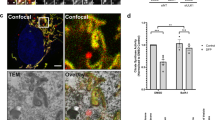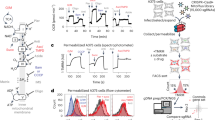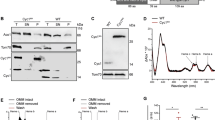Abstract
Functional annotation of complex genomes requires the development of novel experimental platforms with increased capacity. Here, we describe a high-throughput system designed to identify cDNAs whose overexpression induces morphologically distinct cell death modalities. The methodology incorporates two robotized steps, and relies on coexpression of library clones with GFP to reveal the morphological features presented by the dying cells. By using this system we screened 135 000 cDNA clones and obtained 90 independent molecules. Interestingly, three death categories were identified, namely; apoptotic, vacuolated and autophagic. Among the pro-apoptotic clones, we found four members of the mitochondrial carrier family: the phosphate and adenine nucleotide (type 3) transporters, and the mitochondrial carrier homologs (MTCHs) 1 and 2. Expression of these molecules induced cytochrome c release and caspase-9-dependent death. One of them, the phosphate carrier, was able to interact with members of the permeability transition pore complex ANT1 and VDAC1, and its binding to ANT1 was stabilized in the presence of apoptotic activators. Depletion of this carrier by siRNA delayed cytochrome c mobilization and apoptosis. These results attribute a previously undescribed apoptotic function to the phosphate carrier and, more generally, suggest that a common property of various mitochondrial transporters was exploited during evolution to regulate apoptosis.
This is a preview of subscription content, access via your institution
Access options
Subscribe to this journal
Receive 50 print issues and online access
$259.00 per year
only $5.18 per issue
Buy this article
- Purchase on Springer Link
- Instant access to full article PDF
Prices may be subject to local taxes which are calculated during checkout







Similar content being viewed by others
Abbreviations
- PARP:
-
poly(ADP-ribose) polymerase
- PI:
-
propidium iodide
- STS:
-
staurosporine
References
Albayrak T, Grimm S . (2003). A high-throughput screen for single gene activities: isolation of apoptosis inducers. Biochem Biophys Res Commun 304: 772–776.
Bauer MK, Schubert A, Rocks O, Grimm S . (1999). Adenine nucleotide translocase-1, a component of the permeability transition pore, can dominantly induce apoptosis. J Cell Biol 147: 1493–1502.
Brenner C, Grimm S . (2006). The permeability transition pore complex in cancer cell death. Oncogene 25: 4744–4756.
Broker LE, Kruyt FA, Giaccone G . (2005). Cell death independent of caspases: a review. Clin Cancer Res 11: 3155–3162.
Chanda SK, White S, Orth AP, Reisdorph R, Miraglia L, Thomas RS et al. (2003). Genome-scale functional profiling of the mammalian AP-1 signaling pathway. Proc Natl Acad Sci USA 100: 12153–12158.
Crompton M, Barksby E, Johnson N, Capano M . (2002). Mitochondrial intermembrane junctional complexes and their involvement in cell death. Biochimie 84: 143–152.
Faustin B, Rossignol R, Rocher C, Benard G, Malgat M, Letellier T . (2004). Mobilization of adenine nucleotide translocators as molecular bases of the biochemical threshold effect observed in mitochondrial diseases. J Biol Chem 279: 20411–20421.
Garrido C, Galluzzi L, Brunet M, Puig PE, Didelot C, Kroemer G . (2006). Mechanisms of cytochrome c release from mitochondria. Cell Death Differ 13: 1423–1433.
Green DR, Reed JC . (1998). Mitochondria and apoptosis. Science 281: 1309–1312.
Grimm S . (2004). The art and design of genetic screens: mammalian culture cells. Nat Rev Genet 5: 179–189.
Grinberg M, Schwarz M, Zaltsman Y, Eini T, Niv H, Pietrokovski S et al. (2005). Mitochondrial carrier homolog 2 is a target of tBID in cells signaled to die by tumor necrosis factor alpha. Mol Cell Biol 25: 4579–4590.
Halestrap AP . (2004). Mitochondrial permeability: dual role for the ADP/ATP translocator? Nature 430: 1p following 983.
Inbal B, Bialik S, Sabanay I, Shani G, Kimchi A . (2002). DAP kinase and DRP-1 mediate membrane blebbing and the formation of autophagic vesicles during programmed cell death. J Cell Biol 157: 455–468.
Kanzawa T, Zhang L, Xiao L, Germano IM, Kondo Y, Kondo S . (2005). Arsenic trioxide induces autophagic cell death in malignant glioma cells by upregulation of mitochondrial cell death protein BNIP3. Oncogene 24: 980–991.
Kiss-Toth E, Qwarnstrom EE, Dower SK . (2004). Hunting for genes by functional screens. Cytokine Growth Factor Rev 15: 97–102.
Klee M, Pimentel-Muiños FX . (2005). Bcl-X(L) specifically activates Bak to induce swelling and restructuring of the endoplasmic reticulum. J Cell Biol 168: 723–734.
Ko YH, Delannoy M, Hullihen J, Chiu W, Pedersen PL . (2003). Mitochondrial ATP synthasome. Cristae-enriched membranes and a multiwell detergent screening assay yield dispersed single complexes containing the ATP synthase and carriers for Pi and ADP/ATP. J Biol Chem 278: 12305–12309.
Kokoszka JE, Waymire KG, Levy SE, Sligh JE, Cai J, Jones DP et al. (2004). The ADP/ATP translocator is not essential for the mitochondrial permeability transition pore. Nature 427: 461–465.
Matsuda A, Suzuki Y, Honda G, Muramatsu S, Matsuzaki O, Nagano Y et al. (2003). Large-scale identification and characterization of human genes that activate NF-kappaB and MAPK signaling pathways. Oncogene 22: 3307–3318.
Mizushima N . (2004). Methods for monitoring autophagy. Int J Biochem Cell Biol 36: 2491–2502.
Palmieri F . (2004). The mitochondrial transporter family (SLC25): physiological and pathological implications. Pflugers Arch 447: 689–709.
Pimentel-Muiños FX, Seed B . (1999). Regulated commitment of TNF receptor signaling: a molecular switch for death or activation. Immunity 11: 783–793.
Poncet D, Pauleau AL, Szabadkai G, Vozza A, Scholz SR, Le Bras M et al. (2006). Cytopathic effects of the cytomegalovirus-encoded apoptosis inhibitory protein vMIA. J Cell Biol 174: 985–996.
Schobel S, Neumann S, Seed B, Lichtenthaler SF . (2006). Expression cloning screen for modifiers of amyloid precursor protein shedding. Int J Dev Neurosci 24: 141–148.
Schubert A, Grimm S . (2004). Cyclophilin D, a component of the permeability transition-pore, is an apoptosis repressor. Cancer Res 64: 85–93.
Shimizu S, Kanaseki T, Mizushima N, Mizuta T, Arakawa-Kobayashi S, Thompson CB et al. (2004). Role of Bcl-2 family proteins in a non-apoptotic programmed cell death dependent on autophagy genes. Nat Cell Biol 6: 1221–1228.
Sperandio S, de Belle I, Bredesen DE . (2000). An alternative, nonapoptotic form of programmed cell death. Proc Natl Acad Sci USA 97: 14376–14381.
Ting A, Lichtenthaler S, Xavier R, Na SY, Rabizadeh S, Holmes T et al. (2005). Large-scale screens for cDNAs with in vivo activity. Novartis Found Symp 267: 219–229 discussion 229–230.
Van Cruchten S, Van Den Broeck W . (2002). Morphological and biochemical aspects of apoptosis, oncosis and necrosis. Anat Histol Embryol 31: 214–223.
Verrier F, Deniaud A, Lebras M, Metivier D, Kroemer G, Mignotte B et al. (2004). Dynamic evolution of the adenine nucleotide translocase interactome during chemotherapy-induced apoptosis. Oncogene 23: 8049–8064.
Xu X, Shi YC, Gao W, Mao G, Zhao G, Agrawal S et al. (2002). The novel presenilin-1-associated protein is a proapoptotic mitochondrial protein. J Biol Chem 277: 48913–48922.
Yerushalmi GM, Leibowitz-Amit R, Shaharabany M, Tsarfaty I . (2002). Met-HGF/SF signal transduction induces mimp, a novel mitochondrial carrier homologue, which leads to mitochondrial depolarization. Neoplasia 4: 510–522.
Zamora M, Granell M, Mampel T, Vinas O . (2004). Adenine nucleotide translocase 3 (ANT-3) overexpression induces apoptosis in cultured cells. FEBS Lett 563: 155–160.
Zamzami N, Kroemer G . (2001). The mitochondrion in apoptosis: how Pandora's box opens. Nat Rev Mol Cell Biol 2: 67–71.
Zoratti M, Szabo I, De Marchi U . (2005). Mitochondrial permeability transitions: how many doors to the house? Biochim Biophys Acta 1706: 40–52.
Acknowledgements
We thank Dr Brian Seed, in whose laboratory this work was initiated, Dr Atan Gross for the Ab3 anti-MTCH2 antibody, Dr Richard Mulligan for the pMMP, pMD-G and pMD-gag-pol vectors, Dr Felix Randow for P12-MMP, Dr Ute Moll for the LF-OTC-flag construct and CIC members for support. This work was funded by Grants SAF2002-00193, SAF2005-01208 and GEN2003-20239-C06-05 from the Spanish MEC. Additional funding came from the FEDER program of the European Union. SA, MK and JF hold predoctoral fellowships from the Junta de Castilla y León (SA) or the FPU program of the Spanish Government (MK and JF). AF holds a long-term EMBO postdoctoral fellowship. FXP is an investigator affiliated to the University of Salamanca and funded by the Ramón y Cajal program (Spanish Government).
Author information
Authors and Affiliations
Corresponding author
Rights and permissions
About this article
Cite this article
Alcalá, S., Klee, M., Fernández, J. et al. A high-throughput screening for mammalian cell death effectors identifies the mitochondrial phosphate carrier as a regulator of cytochrome c release. Oncogene 27, 44–54 (2008). https://doi.org/10.1038/sj.onc.1210600
Received:
Revised:
Accepted:
Published:
Issue Date:
DOI: https://doi.org/10.1038/sj.onc.1210600
Keywords
This article is cited by
-
CDK5 promotes apoptosis and attenuates chemoresistance in gastric cancer via E2F1 signaling
Cancer Cell International (2023)
-
Inhibition of mitochondrial carrier homolog 2 (MTCH2) suppresses tumor invasion and enhances sensitivity to temozolomide in malignant glioma
Molecular Medicine (2021)
-
Ethanol exposure drives colon location specific cell composition changes in a normal colon crypt 3D organoid model
Scientific Reports (2021)
-
Microfluidic device with brain extracellular matrix promotes structural and functional maturation of human brain organoids
Nature Communications (2021)
-
Co-delivery of Doxorubicin and Curcumin with Polypeptide Nanocarrier for Synergistic Lymphoma Therapy
Scientific Reports (2020)



